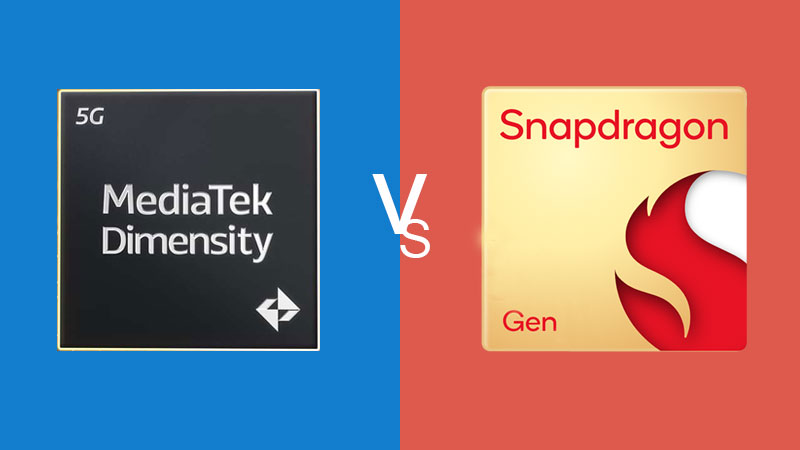In the dynamic landscape of mobile technology, two titans stand at the forefront: Snapdragon, pioneered by Qualcomm, and MediaTek, the Taiwanese contender. Understanding the nuances between these giants is crucial for navigating the diverse world of smartphones and electronic devices. Let’s delve into the core differences, notable chipsets, and the escalating competition between MediaTek and Snapdragon.
The Origins of Qualcomm Snapdragon Vs MediaTek
Qualcomm, an American semiconductor juggernaut, birthed the Snapdragon series, earning its reputation as a cornerstone in mobile innovation. In contrast, MediaTek, a Taiwanese counterpart, gained traction for its cost-effective solutions, catering to a wide spectrum of devices.
Table of Comparison of MediaTek vs. Snapdragon [Blue Vs Red] Processor
| Aspect | MediaTek | Snapdragon |
|---|---|---|
| Origin | Taiwanese contender, known for cost-effective solutions | American pioneer, renowned for mobile innovation |
| Intellectual Property | Holds fewer patents | Boasts extensive patent portfolio |
| Integration | Offers slightly lesser integration, affecting power efficiency | Excels in integration, blending modem, graphics, and AI capabilities |
| Architectural Framework | Leverages ARM’s instruction set architecture | Also utilizes ARM’s instruction set architecture |
| Customization | Licenses ARM’s standard architectures without extensive customization | Benefits from customized ARM architectures, granting flexibility in design |
| Market Share | Niche in mid-range and budget-friendly devices | Dominant presence, particularly in premium and mid-range smartphones |
Intellectual Property and Integration
Snapdragon boasts an extensive patent portfolio, reinforcing its dominance in mobile technology. Qualcomm’s processors excel in integration, seamlessly blending modem, graphics, and AI capabilities for optimal performance and power efficiency. MediaTek, while holding fewer patents, offers a more economical alternative with slightly lesser integration, affecting power efficiency.
Architectural Framework – ARM’s Influence
Both Snapdragon and MediaTek leverage ARM’s instruction set architecture (ISA), with Qualcomm incorporating Cortex-A and Adreno for graphics, while MediaTek employs Mali for its graphical processing needs.
Customization and Market Share
Qualcomm’s Snapdragon benefits from customized ARM architectures, granting flexibility in design. This contributes to its significant market share, particularly in premium and mid-range smartphones. On the flip side, MediaTek licenses ARM’s standard architectures without extensive customization, finding its niche in mid-range and budget-friendly devices.
Performance Showdown: Notable Chipsets
The battle between MediaTek and Snapdragon intensifies with the release of notable chipsets:
Ultra Flagship Showdown: MediaTek Dimensity 9000 vs. Qualcomm Snapdragon 8+ Gen 1 – MediaTek’s Dimensity 9000 showcased prowess in speed, challenging Qualcomm’s dominance. However, the Snapdragon 8+ Gen 1 made significant strides in thermal efficiency, resulting in a tie between the two giants.
Affordable Flagship Duel: MediaTek Dimensity 8100 vs. Qualcomm Snapdragon 870 –
MediaTek’s Dimensity 8100 emerged victorious, offering commendable performance at a more affordable price point compared to Qualcomm’s Snapdragon 870.
Mid-range Battle: MediaTek Dimensity 1200, 1300 vs. Qualcomm Snapdragon 778G –
While MediaTek’s chipsets deliver impressive benchmark scores, Qualcomm’s Snapdragon 778G outshines in thermal management, showcasing a nuanced competition.
Budget Showdown: MediaTek Dimensity 810, 700 vs. Qualcomm Snapdragon 695, 4 Gen – Qualcomm edges slightly ahead with its Snapdragon series in the budget segment, although MediaTek remains a formidable competitor.
Looking Ahead – The Future of MediaTek and Snapdragon
MediaTek’s meteoric rise signals a paradigm shift in the mobile semiconductor landscape. With Qualcomm facing formidable competition, the stage is set for innovation and rivalry. As the industry anticipates the unveiling of Dimensity 9200 and Snapdragon 8 Gen 2, the chipset wars are poised to intensify in 2023.
In this #ExecTalk, Yen-Chi Lee, Deputy GM Smartphone Business Unit, explains how the #Dimensity9300 changes everything. It's a trailblazer for mobile SoCs, boasting the first all-big core design & #genAI capabilities supporting up to 33 billion LLMs. https://t.co/4f3CNK895s pic.twitter.com/wb75xIzM2w
— MediaTek (@MediaTek) February 23, 2024
Exclusive: In episode 1 of “Behind the Silicon: #Snapdragon X,” Qualcomm Sr. VP of Engineering Gerard Williams chats about the design team behind the platform and shares an analogy illustrating how their work laid the foundation for its incredible performance and efficiency. pic.twitter.com/guP49aAspm
— Snapdragon (@Snapdragon) February 23, 2024
FAQ’s
Can MediaTek chipsets compete with Qualcomm Snapdragon in high-end devices?
Recent advancements in MediaTek's Dimensity series, particularly the Dimensity 9000, have positioned MediaTek as a viable contender in the high-end segment. While Qualcomm Snapdragon maintains its stronghold, MediaTek's emergence as a competitor underscores the evolving dynamics of the semiconductor market.
Bottom Up
In the relentless competition between MediaTek and Qualcomm, 2023 promises intriguing developments. MediaTek’s fast rise as a formidable competitor to Qualcomm, especially in the mid-range and budget segments, sets the stage for an exciting future. As we anticipate the Dimensity 9200 and Qualcomm Snapdragon 8 Gen 2, the chipset wars are poised to intensify. The coming year will undoubtedly unravel new technological advancements and further redefine the landscape of mobile processors.
The MediaTek vs. Snapdragon saga reflects the dynamic nature of the semiconductor industry, with both companies offering unique strengths catering to diverse market segments. Whether you prioritize performance, cost-effectiveness, or a balance of both, the choice between MediaTek and Snapdragon hinges on the specific needs of the device and its target audience.

